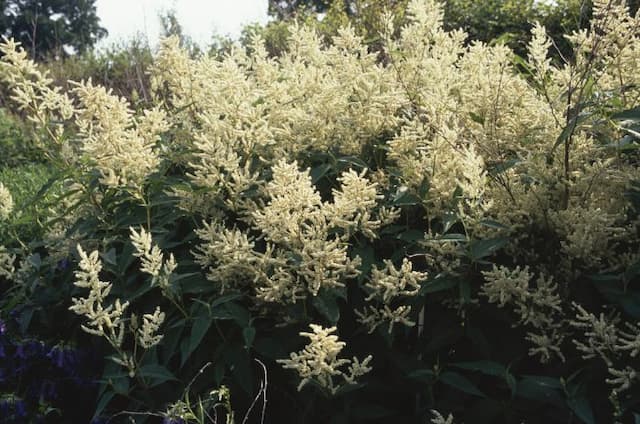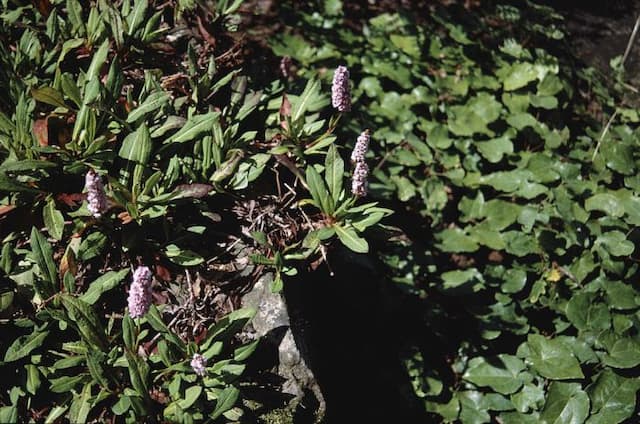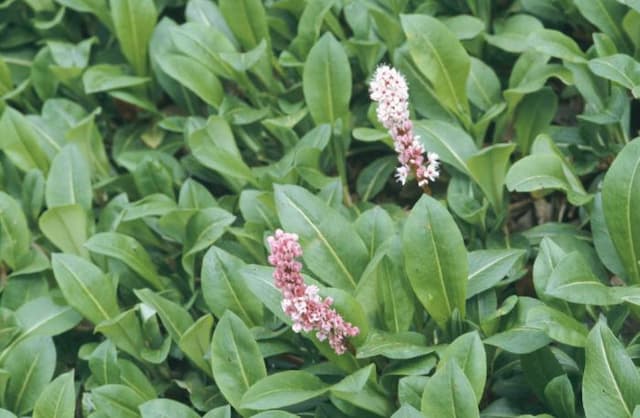Red veined sorrel Rumex sanguineus

ABOUT
Rumex sanguineus, commonly known as Red-veined Sorrel or Bloody Dock, is a striking and decorative plant that is admired for its distinctive foliage. Its leaves are the most remarkable feature, being broadly lance-shaped with a smooth, shiny surface. Each leaf showcases a rich green color that provides a lush background for the intricate network of prominent red or purple veins that give the plant its name. This contrast between the vibrant vein coloration and the green leaf creates a visually appealing and ornamental effect. The overall growth habit of Red-veined Sorrel is a loose, rosette-like formation, with leaves emerging from a central point at the base. During its blooming period, it sends up slender flower stalks that bear small and grouped flowers, adding to the elegant display of the plant. The flowers are usually inconspicuous compared to the dramatic leaves but may add a delicate look to the plant profile with their tiny and greenish to reddish tint. Red-veined Sorrel's ability to act as a culinary herb further enhances its appeal. The tangy and slightly lemony flavor of the leaves can be incorporated into various dishes, contributing both taste and visual flair. Whether grown in gardens for ornamental purposes or cultivated for use in kitchens, Rumex sanguineus is a versatile plant with a unique and striking appearance.
About this plant
 Names
NamesFamily
Polygonaceae.
Synonyms
Red-Veined Sorrel, Bloody Dock, Red-Vein Dock, Wood Dock, Bloodwort.
Common names
Acetosa sanguinea, Lapathum sanguineum, Rumex nemorosus, Rumex nemorosus var. sanguineus.
 Toxicity
ToxicityTo humans
Red-veined sorrel is generally considered edible and is even used in salads for its lemony flavor. However, it contains oxalates, which when consumed in large quantities can bind with calcium in the body and may lead to kidney stones or other issues, particularly in individuals with kidney disorders or susceptibilities. Eating moderate amounts of red-veined sorrel is unlikely to cause toxicity in healthy individuals, but excessive consumption should be avoided, especially by those with existing kidney problems or those vulnerable to oxalate-containing kidney stones.
To pets
Red-veined sorrel, commonly known as red-veined dock, contains oxalates, which can be toxic to pets if ingested in significant quantities. While small amounts might not be harmful, larger doses can cause symptoms such as vomiting, diarrhea, abdominal pain, and potentially kidney damage due to the formation of calcium oxalate crystals. Pets with kidney disease or other health issues may be more susceptible to the effects of oxalates, so it's best to prevent your pets from ingesting large amounts of this plant.
 Characteristics
CharacteristicsLife cycle
Perennials
Foliage type
Deciduous
Color of leaves
Green
Flower color
Green
Height
2-3 feet (0.6-0.9 meters)
Spread
1-2 feet (0.3-0.6 meters)
Plant type
Herb
Hardiness zones
5
Native area
Europe
Benefits
 General Benefits
General Benefits- Edible leaves - Rumex sanguineus, commonly known as red-veined sorrel, has leaves that are edible and can be used in a variety of salads, soups, and sauces for a lemony flavor.
- Ornamental value - The distinctive red veins of the leaves provide an aesthetic appeal, making it a visually attractive addition to gardens and landscapes.
- Culinary versatility - It can be used as a herb or leafy green in culinary practices, offering a unique taste to different dishes.
- Easy to grow - Red-veined sorrel is a hardy plant that can grow in a range of soil types and conditions, making it suitable for novice gardeners.
- Companion planting - It can be used in companion planting to benefit other plants by deterring certain pests or attracting beneficial insects.
 Medical Properties
Medical Properties- Anti-inflammatory: Rumex sanguineus may have compounds that help reduce inflammation.
- Astringent: The plant is traditionally used for its astringent properties, which can help to tighten tissues and reduce discharges.
- Laxative: It has been used as a mild laxative to help with bowel movements.
- Diuretic: Rumex sanguineus is sometimes used to stimulate urine production and relieve fluid retention.
- Antiscorbutic: The high vitamin C content classifies it as a remedy for preventing scurvy.
 Air-purifying Qualities
Air-purifying QualitiesThis plant is not specifically known for air purifying qualities.
 Other Uses
Other Uses- Rumex sanguineus, commonly known as Red-veined Dock, can be used as a natural dye, with various parts of the plant producing different shades on fabric.
- The plant's acidic leaves can be used to curdle milk for simple cheese-making processes.
- In some cultures, the seeds of the Red-veined Dock are saved and used as a grain alternative in porridges and breads.
- The stems of the Red-veined Dock can be woven into baskets or mats because of their fibrous quality.
- Gardeners sometimes use the Red-veined Dock to create a barrier or as a decoy plant to distract pests from more valuable crops.
- The plant can be included in compost mixes, as it adds nutrient diversity to enhance soil quality.
- When dried, the leaves of the Red-veined Dock can be used to stuff small pillows or sachets, sometimes for their mild, tangy scent.
- Its colorful leaves are sometimes used in floral arrangements or pressed and framed as botanical art.
- The seeds of the Red-veined Dock are sometimes used in birdseed mixes to attract a variety of wild birds to gardens.
- Young leaves of the plant can be added to pet feed for rabbits and tortoises as a nutritional supplement.
Interesting Facts
 Feng Shui
Feng ShuiThe Red-veined Dock (Rumex sanguineus) is not used in Feng Shui practice.
 Zodiac Sign Compitability
Zodiac Sign CompitabilityThe Red-veined Dock is not used in astrology practice.
 Plant Symbolism
Plant Symbolism- Patience: Given its common name, Red-Veined Dock, this plant may symbolize patience as docks and sorrels generally take time to establish themselves in the garden or wild.
- Resilience: Red-Veined Dock is known for its hardiness, suggesting the ability to withstand difficult conditions, which can translate into a symbolic message of resilience.
- Health: As many species of Rumex have been used in traditional medicine, the Red-Veined Dock could symbolize health or healing.
- Vitality: The vibrant red veins of this plant contrast with the green leaves, symbolizing energy and vitality, reflecting its robust growth once settled in a suitable habitat.
- Change: The fact that the Red-Veined Dock changes in appearance throughout the seasons, from green to reddish hues, can symbolize adaptability and the constant flux in life.
 Water
WaterBlood sorrel prefers consistently moist soil, so it's important to water when the top inch of soil feels dry to the touch. This might mean watering approximately every week, but it will vary based on temperature and sunlight exposure. Aim to add about 1 inch of water, which equates to around 0.623 gallons per square foot, each time you water. Ensure the water penetrates deeply into the soil to encourage strong root growth, but avoid overwatering to prevent root rot. During the growing season in spring and summer, blood sorrel may require more frequent watering, while in the cooler months, watering can be reduced.
 Light
LightBlood sorrel thrives in full sun to partial shade. It's best to place the plant in a spot where it receives at least 4-6 hours of sunlight daily. If growing indoors, a sunny windowsill that gets plenty of indirect light would be ideal. However, in hot climates, protect blood sorrel from the harsh afternoon sun to prevent leaf scorch.
 Temperature
TemperatureBlood sorrel grows best in temperatures between 60°F and 75°F. It can survive minimum temperatures down to about 20°F, but growth will be significantly slower. To protect your blood sorrel, avoid exposure to temperatures exceeding 90°F for prolonged periods. The plant is quite versatile but thrives in moderate temperatures without extreme fluctuations.
 Pruning
PruningPrune blood sorrel to remove any dead or damaged leaves and encourage bushier growth. Pruning is also necessary to remove flower stalks, as allowing the plant to flower can divert energy away from leaf production. The best time to prune is in the early spring before new growth begins. Prune blood sorrel as often as needed throughout the growing season to maintain its shape and promote fresh, tasty leaves.
 Cleaning
CleaningAs needed
 Soil
SoilRed-veined sorrel prefers well-draining soil rich in organic matter with a slightly acidic to neutral pH of 6.0 to 7.0. A mix of garden soil, compost, and perlite or sand is ideal to ensure proper drainage and fertility.
 Repotting
RepottingRed-veined sorrel should be repotted every one to two years to replenish nutrients in the soil and to accommodate growth, ideally during spring.
 Humidity & Misting
Humidity & MistingRed-veined sorrel thrives in moderate humidity levels, but it is quite adaptable and can tolerate a range of conditions; no specific humidity level is required.
 Suitable locations
Suitable locationsIndoor
Place in bright indirect light; water when topsoil feels dry.
Outdoor
Full sun to partial shade; space 12 inches apart in rich soil.
Hardiness zone
5-9 USDA
 Life cycle
Life cycleRumex sanguineus, commonly known as Red Veined Dock or Wood Dock, begins its life cycle with seed germination, which occurs in warm, moist soil typically in the spring. The seedlings emerge and establish a rosette of basal leaves. As the plant matures, it develops elongated stems and produces distinctive leaves with red or purple veins. Flowering occurs in the summer when small green or reddish flowers blossom on tall flower stalks, and these are followed by the production of seeds contained in a winged fruit. After pollination, which is primarily carried out by wind, the seeds are dispersed to new locations where they can germinate. The plant is a perennial, so it may die back in the winter but regrows from the root system in the following growing season.
 Propogation
PropogationPropogation time
Spring-Early Summer
The most popular method of propagating Red-veined sorrel, which is the common name for Rumex sanguineus, is through seed. Seeds can be directly sown into the garden in early spring as soon as the soil can be worked. Plant the seeds about 1/2 inch deep and spaced about 1 inch apart in rows that are 12 to 18 inches apart. The seeds typically germinate in 7 to 14 days. Once the seedlings are a few inches tall, thin them to stand 8 to 12 inches apart to give each plant enough room to mature. It's important to keep the soil moist but not waterlogged during the germination and early growth phases. Since Red-veined sorrel is a hardy perennial, once established, it can produce new shoots every spring from its overwintered root system.

![Red bistort [JS Seven Oaks Village]](/_next/image?url=https%3A%2F%2Fplants-admin.emdemapps.com%2Fimages%2Fplants%2F%2Fimages%2F604b56557c0e3.png&w=640&q=75)







